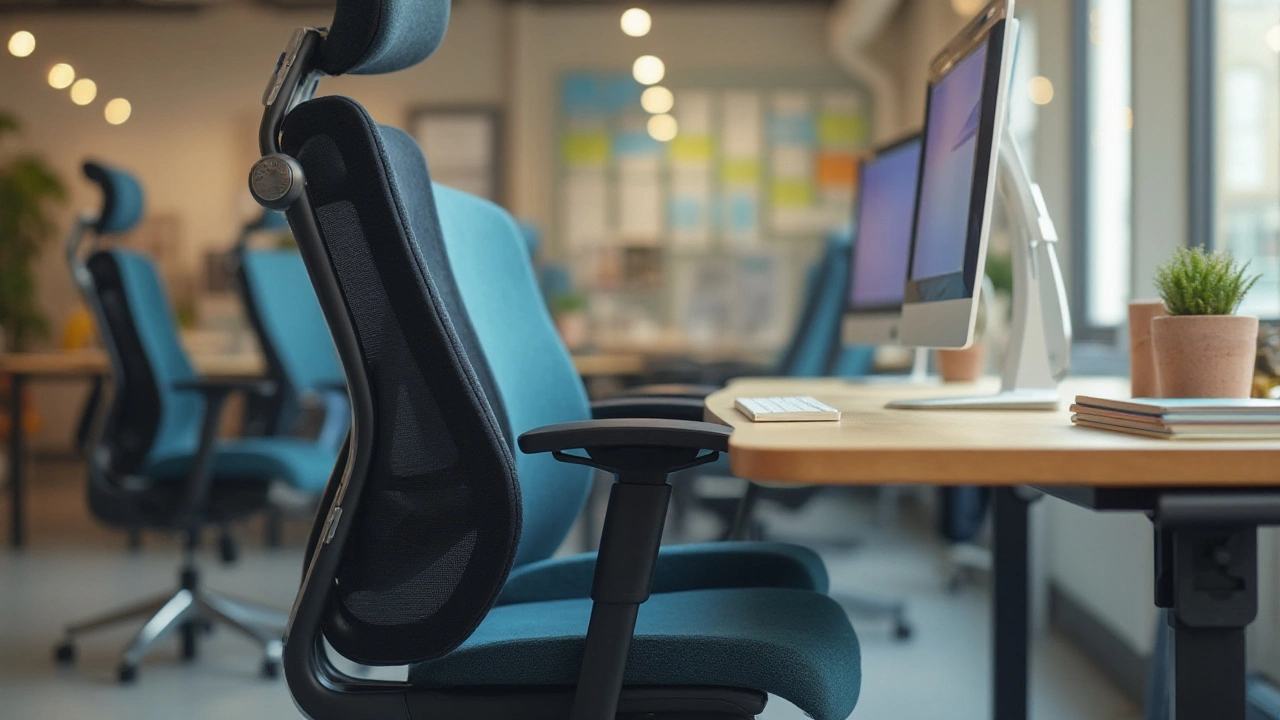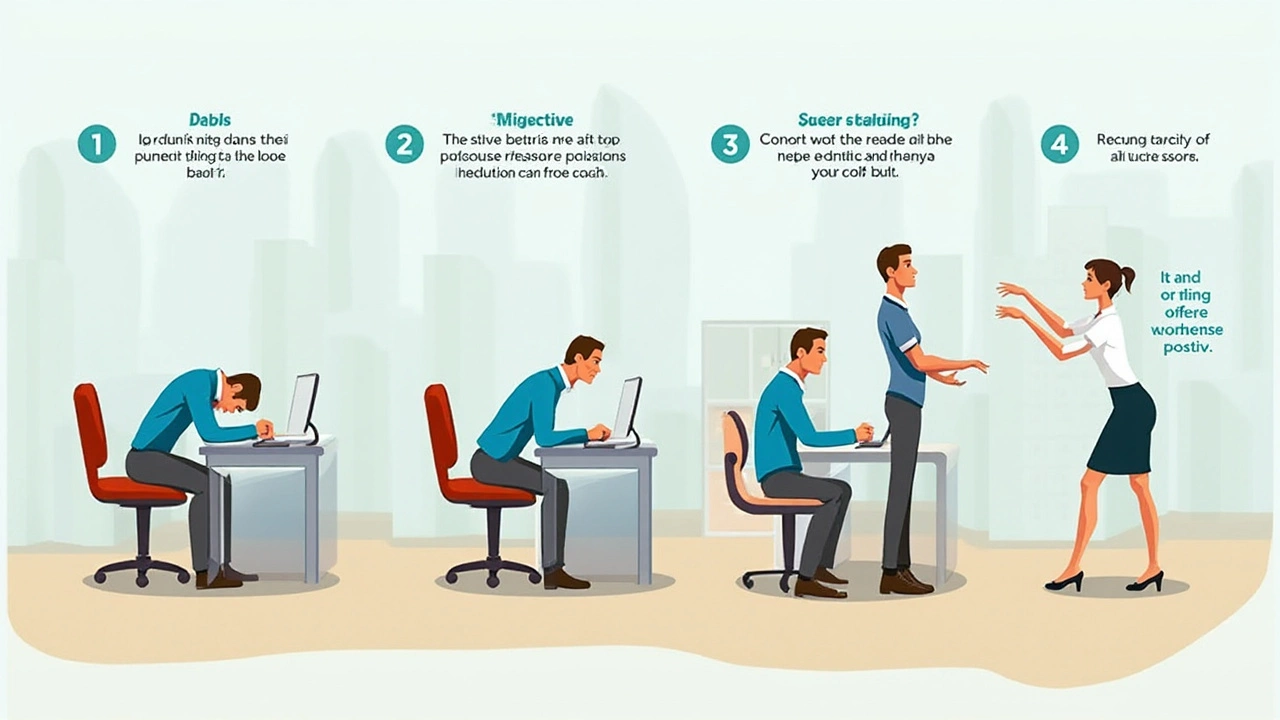Sitting in an office chair is something many of us do for hours on end, but have you ever wondered if you're doing it right? The way you sit can greatly affect your health and comfort, not to mention your productivity at work. It's not just about taking a seat and getting started with your tasks. Ergonomics plays a crucial role in ensuring that the hours you spend sitting do not take a toll on your body.
Good posture acts as a foundation for comfort and efficiency. However, achieving it requires more than just a straight back. There are numerous factors to consider, from the chair's height to the position of your feet. Understanding these elements can make a huge difference in avoiding pain and strain.
In this article, let's delve into simple yet effective strategies to optimize your sitting position. You’ll also learn how to make the necessary chair adjustments and steer clear of detrimental habits. Whether you're new to office work or have been at it for years, these insights will help you thrive while seated.
- The Importance of Ergonomics
- Achieving Optimal Posture
- Essential Chair Adjustments
- Common Mistakes and How to Avoid Them
The Importance of Ergonomics
At its core, ergonomics seeks to create a harmonious relationship between our bodies and the tools we use, especially in the workplace. Understanding and adopting ergonomic principles can significantly reduce the physical stress experienced during long hours of working at a desk. Imagine a chair being much more than a seat; it is an integral part of your working life that, when adjusted correctly, can offer immense comfort and support. Ergonomics comes into play by ensuring your chair supports your unique body structure, from your back's natural curvature to the height at which your legs rest flatly on the ground. This awareness extends beyond mere comfort; it directly impacts your long-term health. Poor sitting habits can lead to neck pain, back discomfort, and even exacerbate existing conditions like carpal tunnel syndrome. Considering how a sedentary lifestyle can already take a toll on your health, it's vital to pay attention to ergonomics to counterbalance these risks.
But it's not just about health implications. The benefits of good ergonomics also spill over into the realm of productivity. Comfortable employees, free from the distraction of physical discomfort or pain, tend to stay focused and remain engaged in their tasks longer. This is because ergonomic adjustments are tailored towards improving efficiency by minimizing unnecessary movements and providing the easiest access to the tools you need. This level of efficiency can make work much more enjoyable and less of a strain, physically and mentally. The key to unlocking this potential lies in personalizing your workspace to suit your individual needs, and ergonomic office chairs play a critical role in this customization.
According to a study conducted by Cornell University, employees who had access to ergonomically fitted furniture showed a 17.4% increase in productivity. This demonstrates that investing in ergonomic solutions is not only about taking care of employee health but also enhances organizational success. Achieving optimal ergonomics is more manageable than it might seem. By adjusting the height of your chair so your eyes perfectly align with the top third of your screen, setting a slight recline on your chair back, and ensuring armrests support your forearms comfortably, the desk becomes a comfortable command center rather than a battleground for your back. This simple yet impactful adjustment can transform how sitting affects your daily routine.
"The real magic of ergonomics doesn't lie in its elaborate designs—it’s in its ability to be personalized," says Sarah Morgan, an ergonomics specialist at the Ergonomic Center at North Carolina. "When you tailor your environment to fit you like a glove, it reduces injuries and increases satisfaction."
In essence, taking ergonomics seriously implies not just passively accepting the tools that surround us; instead, it challenges us to adjust those tools to make them work for us. What may seem like minor modifications to your seating arrangement can ultimately lead to significant improvements both in health and workplace happiness. Embracing such practices can tip the scales towards a much more balanced and sustainable work life, making every hour spent at your desk feel less taxing on your body and more rewarding for your mind.

Achieving Optimal Posture
Sitting with the right posture is not just about looking professional; it’s vital for maintaining good health over time. An optimal sitting posture begins with adjusting your position in relation to your office chair’s design. Make sure your back is aligned against the chair backrest which supports your natural spine curvature. Your muscles will appreciate a break, avoiding tension and discomfort that often arise from poor posture.
Your feet should be stationed flat on the floor, ensuring that your knees are at the same level or slightly below your hips. This angle facilitates blood flow and minimizes the risk of deep vein thrombosis, a condition aggravated by prolonged sitting. An interesting fact to note is that keeping knees below hips can help ease pressure on the lower back. Harvard Health Publishing states that "slumping forward increases pressure on the discs and vertebrae of the lower back."
Kathy Brooks, an ergonomics specialist, once said, "A chair should follow the spine’s natural curve with a firm lumbar support, promoting alignment and decreasing strain."
Elbow positioning also plays a crucial role in achieving this sought-after posture. Your elbows should hover near your waist, forming about a 90-degree angle as your hands rest comfortably on the desk or keyboard. Practicing this positioning can prevent strain on the shoulders and wrists. Moreover, be mindful of screen height; it should be directly at eye level to avert tilting of the head, which can lead to neck issues over time. Implementing these changes might seem trivial, yet they significantly improve day-to-day comfort while reducing wear on the body's musculoskeletal system.
Let's delve into specific modifications that individuals often overlook. Some keys to vibrant, pain-free posture lie in tailoring your office chair to meet personal needs, especially when considering the backrest recline angle and seat depth. Adjust the recline angle slightly backward, which studies show can distribute pressure more evenly across the back. Make use of seat depth adjustment if available; the space between the edge of the chair and your knees should allow a few fingers to pass through comfortably. Such small alterations keep discomfort at bay as you delve deeper into your daily work endeavors.
For visual learners seeking optimal posture tips, seeing a chiropractor or physical therapist can provide insights that transform your workspace into an oasis of ergonomic excellence. They often recommend incorporating movement throughout your day by taking short, frequent breaks. Changing positions ensures muscles remain engaged, reducing stiffness and promoting circulation. The path to perfect posture requires commitment and awareness but the benefits, from preventing injuries to enhancing productivity, make these efforts worthwhile.

Essential Chair Adjustments
When it comes to optimizing your seat for health and productivity, adjusting your office chair is key. Yet, many workers overlook the potential discomfort caused by improper chair settings. An office chair isn't a one-size-fits-all affair. To ensure the chair supports your body correctly, consider the individual needs of your posture, desk, and even your daily tasks. Proper adjustment can transform your chair into a haven of comfort and help you maintain a healthy sitting posture throughout your workday.
To start, focus on the office chair ergonomics. Ensure that your chair's height is suitable for your desk. The primary goal here is to keep your feet flat on the floor with your knees bent at approximately a 90-degree angle. This position minimizes strain on your lower back and legs. If your feet dangle, consider using a footrest. Adjusting the height prevents your thighs from being compressed, which can hinder circulation over time. A well-adjusted height is the first step toward a healthier sitting experience.
The depth of the chair's seat is just as important. Ensure there's a small gap, roughly the size of a clenched fist, between the back of your knees and the seat edge. Too much pressure at the back of your knees can lead to discomfort and circulation problems. Adjusting the seat depth allows your lower back to remain against the backrest comfortably, which provides necessary lumbar support. If your chair allows for sliding the seat, take advantage of this feature to fine-tune the position.
Backrest and Armrest Adjustments
The backrest angle plays a vital role in maintaining proper posture. A slight recline of 100 to 110 degrees can alleviate pressure on your spine and distribute your weight safely across your back. Adjustable lumbar support is another crucial feature; its purpose is to support the natural curve of your lumbar spine. Fine-tune this element to follow your body's silhouette closely. When making backrest adjustments, remember that regular shifting and micro-movements during the day contribute to spine health.
Armrests are often underrated but can significantly contribute to your workplace comfort. They should be adjusted so that your elbows are close to your body and form a 90 to 120-degree angle when typing. This positioning reduces stress on shoulders and upper arms, aligning your forearms parallel to the floor. Some chairs offer height and width adjustments for the armrests to accommodate different body sizes and shapes. Proper armrest training throughout a workday reduces the risk of developing computer-related musculoskeletal strains.
“The right chair adjustments not only improve comfort but also increase your efficiency, as they help reduce fatigue and prevent long-term injuries,” says Dr. Jane Johnson, an ergonomics specialist at the Workplace Research Institute.
It's not uncommon to find chairs equipped with advanced features like tilt tension and synchronous tilt mechanism. Tilt tension adjusts the force required to lean back, allowing you to exert natural bending without sudden and unintended movements. In chairs with synchronous tilt, the backrest and seat move in relation to each other, promoting an active sitting posture while keeping your feet stable on the ground. These features fortify the dynamic support of your body throughout prolonged sitting sessions, balancing flexibility with stability.
Don't forget the significance of regular maintenance on your chair to ensure functionality. Inspect elements like wheel casters and seat cushioning as part of routine upkeep. After all, even the best chair can't provide benefits if its parts are worn or broken. Utilizing these healthiest sitting positions and ensuring appropriate adjustments will help keep back pain at bay and elevate your workplace satisfaction. Tailor these chair settings to your preferences and enjoy a hassle-free working environment.

Common Mistakes and How to Avoid Them
When we settle in for the daily grind at our desks, it's easy to slip into habits that take a toll on our wellbeing. One common mistake is slouching or leaning forward as the hours tick by. This posture can lead to back and neck pain by placing undue pressure on the spine. It's not just about the discomfort, but prolonged slouching might even affect your long-term spinal health. Instead, aim for an upright posture with your back resting comfortably against the chair. Investing in chairs designed with ergonomics in mind can truly make a difference, helping you maintain a natural curve in your spine.
Another frequent error is neglecting to adjust your chair to fit your individual needs. Many people sit in a office chair straight out of the box, without making the necessary tweaks. For instance, a chair that's too high or too low might hinder blood circulation, leading to numbness or fatigue. It's important to ensure your feet are flat on the floor and your thighs are parallel, or slightly inclined, in relation to the seat. Also, your knees should be level with or just below your hips. Adjust the seat height and angle to achieve these criteria—it’s a relatively simple fix with significant benefits.
Frequently overlooked is the setup of screen and desk alongside the chair. An awkward desk height or a monitor that’s not at eye level can cause you to crane your neck or hunch, straining your back and shoulders. Your keyboard and mouse placement plays into this: ideally, your elbows should be close to your body and form a 90-degree angle when typing. The screen should be about an arm's length away with the top of the screen at or just below eye level. This helps maintain a relaxed and neutral head position throughout the day.
Maintaining a static position for long periods is another habit to break. The repetition of sitting still for hours doesn't just wear on your body, it hinders your productivity too. Research indicates that regular breaks boost both well-being and performance. Aim to stand, stretch, or move around every 30 minutes or so. A study by the Mayo Clinic found that short, frequent walks substantially improve mood and energy levels. A reminder on your phone or computer can be a simple way to integrate this into your routine without disrupting your workflow.
Lastly, don't underestimate the value of a good cushion. Using lumbar support, such as a small pillow or specially designed cushion, helps sustain the natural curve of your spine. Similarly, a cushioned seat pad can increase comfort during prolonged sitting. According to The Ergonomics Society, proper padding reduces discomfort and supports good posture. Selecting the right modifications can turn a mundane office chair into a pivotal element of a healthy, efficient workspace. Avoiding these common pitfalls does more than protect your body—it elevates your entire workday experience.








